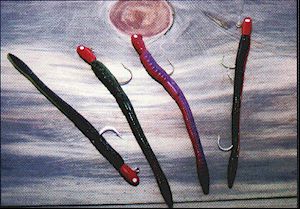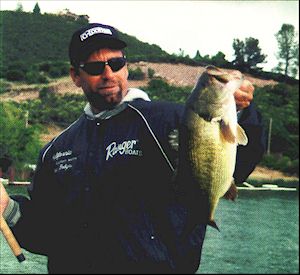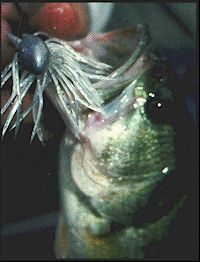Fishing Deep
Story and Photos by Margie Anderson
Reprinted by permission of Bass
West USA Magazine.
 Fishing
deep intimidates some anglers. After all, casting to shore is
relatively easy - you have a highly visible target (shoreline)
and all you have to do is choose a lure and cover the water. If
the fish are up shallow, that's the way to go. But let's face it
- a lot of times the fish just aren't there. During the summer
especially, when water temperatures soar and dissolved oxygen is
scarce in the shallows, the bass will just be more comfortable
down deep. But warmer water means they need to eat more, so an
angler who masters deep-water fishing techniques can be extremely
successful. Fishing
deep intimidates some anglers. After all, casting to shore is
relatively easy - you have a highly visible target (shoreline)
and all you have to do is choose a lure and cover the water. If
the fish are up shallow, that's the way to go. But let's face it
- a lot of times the fish just aren't there. During the summer
especially, when water temperatures soar and dissolved oxygen is
scarce in the shallows, the bass will just be more comfortable
down deep. But warmer water means they need to eat more, so an
angler who masters deep-water fishing techniques can be extremely
successful.
Clifford Pirch, a bass guide and tournament angler in Payson,
Arizona, discovered deep-water fishing at a very early age. In
the lakes of central Arizona. Clifford has been making a pretty
good living catching fish and showing others to to do it.
"Your first challenge is to find the fish," Clifford
says. "Once, you know where they are, figuring out how to
make them eat is usually pretty easy." It helps to know the
lake, and that's where maps, depthfinders and GPS units come in.
FINDING STRUCTURE
A good lake map is an invaluable aid to finding structure,
but it's just a starting point, says Pirch. Marking a map with
different colored pens at twenty-foot intervals will show you
immediately where the major drop-offs and points are. Once you've
located a few of those, you need to get out there and go over the
area slowly, watching your graph the entire time. A lot of subtle
and even not-so-subtle breaks and humps will simply not be shown
on the map. When you find them, mark them on your own map. They
are potential gold mines.
"One thing I've noticed is that a lot of times a point
will run out really long and deep," says Pirch, "and
then it will come back up 'way out in the lake. Those humps at
the ends of points are dynamite areas for big bass and most
fishermen don't find them." He makes sure he follows each
point out as far as he can, and watches carefully for any sign
that the bottom is coming back up. Clifford zig-zags back and
forth over the point for the whole distance, watching the graph
and making note of any break, rock-pile, submerged tree, or hump.
"A point is good structure," he explains, "but it
can take a lot of time to fish an entire point. I look for
structure ON the structure, and concentrate on fishing that. It's
where I usually find concentrations of fish."
 Clifford
examines channels, reefs, humps, and bluffs the same way. All
these large pieces of structure can be intimidating, and they can
be almost impossible to cover thoroughly when the bite is slow.
Finding the hotspots within the structure is the key. When he
comes to a large flat, Pirch always heads out toward open water,
looking for the edge of the flat. If he finds a definite break,
he's in business. A sharp break or a steep channel cutting
through a flat is bass habitat from heaven. "Bass like to
have a place where they can come up shallow to grab a quick meal,
and be able to got back to deeper water real quick," he
says. "Any place that has all that is a good place to
fish." Clifford
examines channels, reefs, humps, and bluffs the same way. All
these large pieces of structure can be intimidating, and they can
be almost impossible to cover thoroughly when the bite is slow.
Finding the hotspots within the structure is the key. When he
comes to a large flat, Pirch always heads out toward open water,
looking for the edge of the flat. If he finds a definite break,
he's in business. A sharp break or a steep channel cutting
through a flat is bass habitat from heaven. "Bass like to
have a place where they can come up shallow to grab a quick meal,
and be able to got back to deeper water real quick," he
says. "Any place that has all that is a good place to
fish."
PRE-RIGGED WORMS
Clifford took us to the lake one summer afternoon to show us
what he means. Stopping the boat about a hundred yards from
shore, he moved around on the trolling motor watching the graph.
"There is a big flat over there," he explained,
"and a channel comes out next to it. There's a point on the
other side of the channel, and it takes a turn right around here.
The bend is covered with jumbled rock. I catch some nice fish
here." Once he was satisfied with the boat position, Pirch
took out a pre-rigged worm and dropped it straight down to the
bottom.
"These things are awesome for fishing deep water,"
he told us. "Sometimes the fish bite so lightly that you can
hardly feel it. But with these pre-rigged worms they just about
set the hook on themselves." He usually starts out hopping
the worm, and if he's not getting bit he slows down. Pre-rigged
worms are light, so he fishes them on spinning gear with 6- to
8-pound-test line. When he feels pressure on the line, he just
starts reeling to set the hook. "With this light line you
need to back off the drag when you get a really big fish
on," he warned us. "The hooks on these things can
straighten right out if you're not careful."
Almost an hour went by with no fish, but Pirch was absolutely
convinced that the bass were close by. He fished carefully,
moving the boat around over the structure. And it paid off - he
finally found the fish on the side of the bend, and within a half
hour we had six fish in the boat. "That would be a good
limit in a hurry, wouldn't it?" he grinned.
 Pre-rigged
worms are excellent deep-water lures when you already know where
the fish are. If you're searching, a split-shot rig or a Carolina
rig might he a better choice, he says. "I don't start
looking for how deep the fish are until I get to the spot,"
he explains. "Once I get where I'm going I watch the graph.
If I see baitfish, then that's the depth I fish. If the fish are
right on the bottom I throw a jig or a Press-Ur-Bite worm or a
Westy Worm. If they're suspended, I'II start with a spoon or a
Carolina rig." Pre-rigged
worms are excellent deep-water lures when you already know where
the fish are. If you're searching, a split-shot rig or a Carolina
rig might he a better choice, he says. "I don't start
looking for how deep the fish are until I get to the spot,"
he explains. "Once I get where I'm going I watch the graph.
If I see baitfish, then that's the depth I fish. If the fish are
right on the bottom I throw a jig or a Press-Ur-Bite worm or a
Westy Worm. If they're suspended, I'II start with a spoon or a
Carolina rig."
JIGS
Gary Dobyns is one of those guys who prefers to throw big stuff
whenever he can. For deep-water fishing a one-tonner jig is a
lure he gets a lot of mileage out of. "I like these
one-ounce football head jigs a lot," Gary says,
"because they get down deep really fast and you can do just
about anything with them and still catch fish." Dobyns
favors Yamamoto Hula Grubs on his jigs - they combine the skirt
and twin-tail in one bait. "I'm just lazy I guess," he
explains, "and I like to be able to deal with one bag
instead of two." Other anglers like the grubs and skirts
separate so they can combine colors.
Dobyns is a meat-and-potatoes fisherman. He likes to keep
things simple and effective. When he throws a jig he just casts
it out and starts crashing it around on the bottom. "You can
bounce it, crash it, hop it, drag it, or swim it," he says,
"and you'll still catch fish on it." These big jigs in
deep water require some stout tackle, so Gary uses a Loomis
flippin' stick and 15-pound-test P-Line. If he's crashing the jig
around on rocks he checks his line and knot often. "Nothing
ruins your day like losing a big fish at the boat," he says,
"especially when it's your own darn fault!"
 "Once
you get a bite you need to reel up and get the line taut,"
says Gary, "and then you need to set that hook HARD. In deep
water there's a lot of line out, so make sure you use good jigs.
I like the Yamamoto ones because they're made with Gamakatsu
hooks. Once you have the hook set, keep that fish coming. If you
let him get any slack at all he can throw the hook. Don't keep
switching the rod back and forth - keep him coming one way and
never let up on the pressure. And it helps to have a net handy
when you get him to the side of the boat!" "Once
you get a bite you need to reel up and get the line taut,"
says Gary, "and then you need to set that hook HARD. In deep
water there's a lot of line out, so make sure you use good jigs.
I like the Yamamoto ones because they're made with Gamakatsu
hooks. Once you have the hook set, keep that fish coming. If you
let him get any slack at all he can throw the hook. Don't keep
switching the rod back and forth - keep him coming one way and
never let up on the pressure. And it helps to have a net handy
when you get him to the side of the boat!"
Dobyns likes to throw big football head jigs on anything that
looks like crawfish territory. "I think the bass treat those
jigs like crawdads," he says. "Sometimes they hit it
real hard but they don't take it. It's like they're just hitting
it to stun it or kill it. If you don't move the bait too much
they'll come back and eat it. Wait until you feel some pressure
before you set the hook."
"SISSY STUFF"
Better not call finesse baits "sissy stuff" around Don
Iovino or Mike Baldwin. Both of these guys have made a ton of
money throwing finesse baits. "Heck," says Baldwin,
"if the big bass are cruising the shoreline eating
crankbaits and blades, you'd be a fool to mess around with little
worms. But when the bite gets tough, small baits and light line
can really save you." Baldwin should know - he spends a lot
of time fishing the clear waters of the Colorado River
impoundments, and when the bite gets tough there, it's REALLY
tough. When he can, he catches fish by pitching blades and jigs
to the rushes, but a lot of times he's forced out into deeper
water. That's when he finds that split-shotting, drop-shotting,
doodling, or bouncing a grub on a pea-head saves the day.
"Basically, when the fish move out away from shore I
throw whatever can be worked the easiest," Mike says.
"I mean if the fish are hiding in deep brush, I have to use
something that can get in there to them. That's usually shaking a
worm. But if I come to a sharp wall I'll bounce a little grub
down it on a pea-head jig." If Baldwin just needs to cover
some open ground, he'll use a split-shot or a drop-shot rig.
"One of the keys is to know when to switch," he
says. "I was in a tournament on Havasu once and I was just
killing them on spinnerbaits the first day. But the second day I
couldn't buy a bite, even in my best areas. I tried for a while,
then I finally moved out and started dragging a split-shot rig
around. In no time at all I started catching fish. You just have
to know when to give up on the shallow stuff. It can turn off in
a heartbeat."
There's no denying that most anglers would much rather fish
shallow than deep. And when the fish are cooperating, that's
great. But during summer and winter you'll find more fish deep
more often. If you take the time to find the most likely spots,
then fish them thoroughly, it will really pay off for you.
Reprinted by permission of Bass
West USA Magazine.
 About
the Author About
the Author
An active member of
OWAA (Outdoor Writers Assoc. of America) since 1991, Margie
Anderson usually writes 50 to 60 fishing articles that
get published each year. She fishes All Star team tournaments
with her husband, John. Together, they do a lot of work with
kids, especially Pathway to Fishing. These youth events and
seminars are held at shopping malls, schools, parks, sports
stores and other convenient locations for parents and kids.
Margie and John also like to hunt a lot.
|
